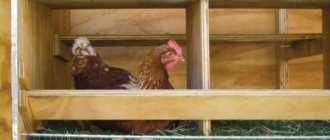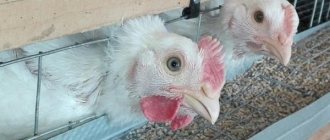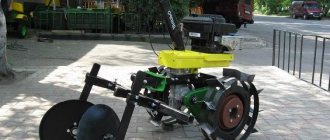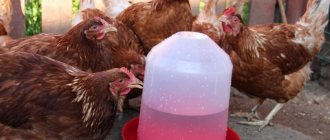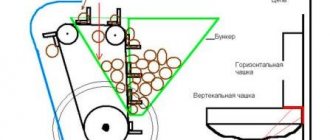Author's rating
Author of the article
Smirnov Anton Egorovich
Poultry farmer with 20 years of experience
Articles written
8
A chicken roost is a bar or perch in a chicken coop where birds can rest and sleep. Also, its role can be played by nests, which are boxes with bedding, located in a row at a certain height from the floor. These are important elements of any poultry house, because the health of the flock directly depends on the comfort in it. Let's figure out what kind of perches for chickens should be, what types there are, and how to make original versions yourself.
Purpose
Tasks of the nest and perch for chickens:
- rest and sleep (conditions are close to natural);
- reducing the risk of infection by pathogenic microorganisms that can reside and multiply in dirty litter;
- ensuring safety (small predators will not reach them on roosts);
- preventing frostbite;
- ensuring cleanliness (their own feces do not stick to the chickens).
Expert opinion
Firsov Sergey Arkadevich
Poultry farmer
Attention! Perches and nests for chickens are an indispensable attribute of a poultry house; it is impossible to do without them. However, you don’t have to spend money on buying them; you can do everything on your own.
Primary requirements
Chickens on the roost should be kept at a distance from each other so as not to disturb their neighbors while moving. The pole cannot be very thick so that the birds can grab it with their paws .
Primary requirements:
- Material. You cannot use iron pipes, as the paws will freeze to them. The best option would be to plan the wood so that there are no splinters. It is not recommended to paint it, because the coating will peel off with regular cleaning. A smooth surface will be easier to clean, but birds do not like too smooth perches; it is desirable that it be slightly rough.
- Length. Depends on the number of individuals in the herd. For one laying hen, 18-25 cm will be enough. If the distance is smaller, stronger individuals will begin to throw off weaker ones. When choosing the length, you should also consider that it should not be too long. Otherwise, the pole will begin to bend. With a large population, it is better to make several perches.
- Diameter. When birds sit on branches in their natural environment, they clasp them with their paws to avoid falling, three fingers are located in front, and one behind. Therefore, it is unacceptable to use boards, thick logs and poles, or thin sticks as a perch. The ideal option would be a block with rounded and planed edges measuring 40 by 60 or 50 by 50 mm. To select the diameter even more accurately, you can measure the length of the chicken foot when open. The width of the pole is ½ of this value.
- Height. For laying hens it is 0.6 m from the floor. For large specimens, you can install a pole at a height of 0.8 m.
Expert opinion
Firsov Sergey Arkadevich
Poultry farmer
For reference! The optimal size of nests for chickens is 0.25 m width, 0.35 m depth and height. For egg individuals - 30 cm x 40 cm x 45 cm, respectively.
Original ideas
Chickens are very unpretentious in terms of sleeping places. They need to be comfortable and located in cozy and not too lit corners.
However, the owners are trying and coming up with more and more new ideas on how to transform the birds’ resting place.
Particularly noteworthy are entire castles for chickens, made from old cabinets, in which each laying hen is given its own apartment with personal perches, nests and egg collectors.
Perches made from car tires are no less original. Moreover, they are often given various forms, for example, a flower.
Bright houses with roofs, made over a regular wooden perch, are also popular among poultry farmers.
Some especially caring people even make small curtains at the entrance, which are gathered on the sides so as not to interfere with the birds getting into the sleeping area.
Varieties
Let's look at the most convenient types of perches for laying hens with our own hands. Let's figure out how much the materials for their construction will cost approximately.
The simplest option
It is a block fixed along the wall at a distance of 0.35-0.4 m. The most important thing is that it is motionless and cannot turn over when the birds land on it.
This idea has the following advantages:
- it is easy to clean under the perch;
- making a roost for chickens with your own hands will not be difficult;
- There will be fewer fights between birds.
The disadvantages include the fact that only a small number of individuals will be able to rest on the roost..
Corner in several rows
Helps save space. It consists of several bars at different heights, which are located in the corner between adjacent walls.
They have the following advantages:
- allows you to save space (in addition to the fact that the perches are in several rows, they can also be placed in all corners);
- easy to do yourself;
- nothing will disturb the birds.
One of the disadvantages is that it is difficult to remove droppings under such a structure. This problem is solved by installing removable bars in the lower rows.
Perimeter bars
Similar to the first option, but the block is installed not against one wall, but along the entire perimeter.
Hygienic perch
It is a table with a tray for collecting litter (box), above which there are several rows of perches. Such structures are mobile. They are usually used for temporary detention, incl. when training them to roost. They have the following advantages:
- the most hygienic type, which is easy to clean;
- does not require much space;
- can be transferred;
- allows you to quickly train chickens to roost;
- can be used with large herds.
The disadvantages include the fact that manufacturing will require more materials and time.
Lattice
Can be made with or without a crossbar. When choosing the second option, the lattice box of the base is lowered, the birds, sitting down and getting up, do not get their feet dirty in feces. Caring for such a perch is quite simple; as the base box fills, it must be cleaned. However, this design idea is suitable for those who do not have very many chickens.
With pallet
Reminiscent of the previous version, with only one difference. The pallet can be placed under the poles, which are arranged in several rows. This allows you to accommodate many birds.
The pallet is installed on bars at a distance of 0.3-0.4 m from the floor. To save usable space, this space can be used to place nests.
Expert opinion
Firsov Sergey Arkadevich
Poultry farmer
Note! The edges of the tray should be planed and rounded so that the birds cannot be injured.
How to make
Whatever type of perches is chosen, they are constructed according to approximately the same principle:
- Make a plan drawing of the poultry house in which the pole will be placed. Make notes where waterers, feeders, windows and doors are located to determine how to properly place nests and perches.
- Prepare materials. It is recommended to use hardwood blocks that will not sag under the chickens.
- Adjust the beams to size and sand them.
- When attaching to the wall, prepare support bars with grooves. The cross-section of the second element is 2-3 mm larger than the first. This will ensure free installation of the poles and their secure fixation.
- Use nails or self-tapping screws for fastening.
- Install the poles into the grooves. Check them for strength; if they bend, make an auxiliary support in the middle of the block. When installing perches, use a building level to avoid distortions.
- If a design with a pallet is used, keep in mind that it should cover the entire space under the poles, even protrude a little.
- When choosing a portable option, four bars are used. A pallet is installed on the bottom two, and grooves for the poles are cut out on the top ones.
Expert opinion
Firsov Sergey Arkadevich
Poultry farmer
Note! If conifers are used to make the perch, they need to be calcined. This will help avoid rotting.
Prices for timber
You can buy timber for perches at approximately the following cost:
Prices for popular models of jigsaws
To make a roost for chickens you will need a jigsaw. You can purchase it at approximately the following cost:
At what height should I do it and where should I place it in the chicken coop?
Many owners are wondering where to place the roost so that it becomes a place of complete rest for the living creatures. Under natural conditions, birds climb to roost on high branches of trees to hide from predators.
Accordingly, at the level of instinct, chickens will strive to find a higher place to sleep; the owner’s task is to select a structure of the required height. It will be different for each breed. On average, this figure is from 60 cm to a meter. (More information regarding the height of the bars for different breeds is shown in the table.)
The perch in the chicken coop should be installed in a secluded place so that the bird feels safe. This can be a darkened part of the room, away from windows and doors, so that the laying hens’ roosting area will be protected from bright light and drafts.
Did you know? Chickens lay eggs mainly during the daytime. The main condition is the presence of light, and its origin does not matter (artificial lighting can serve as an alternative to natural).
Instructions for each variety
Instructions with photos will be presented below.
The simplest option
How to make a perch for chickens of this variety:
- Having calculated the required length, install the side supports.
- Process the timber that will act as a pole.
- Place the perch on supports at a distance of 30 cm from the wall and check for strength.
- At a distance of 40 cm from the floor, nail the bars onto the side strips on which the pallet will be installed.
- Take a metal sheet, bend its edges so that you get a pallet with sides 3-10 cm high. Place it on the prepared bars.
- If necessary, construct a ladder and install it on the side. This is optional.
Box
Step by step steps:
- Construct the walls of the box from boards.
- The bottom is made of plywood.
- Attach slats along the inner perimeter to secure the mesh.
- Install 2 slats with grooves under the pole.
Lattice
Step by step steps:
- Attach hinges to the rectangular frame to secure the folding mesh.
- On one side, fix the structure on the wall, and on the other, attach 2 support strips.
Hygienic
Step by step steps:
- To make it, you can use an old table or put together one yourself.
- Install strips with grooves for the poles on the sides.
- Install and secure the bars that will serve as a perch.
Sleeping place with 2 rows
Two-level perches are made similarly to the simple version from a bar. They should be located at a slope of 60 degrees. The distance between rows for large and medium-sized individuals should be 0.45-0.5 m, for small breeds - 0.35-0.4 m.
Video
It is recommended to watch this useful video for those who raise chickens or are planning to do so:
Roost training
Some chickens sleep, rest and rush wherever they go. This is usually observed among young individuals who do it out of ignorance. They will have to be perched on their own over several days and sometimes weeks.
As it became clear, it is not difficult to make a perch using your own efforts. All that is required is time and basic carpentry skills. Thanks to a properly organized sleeping area, the chickens will be comfortable, they will develop and lay eggs better.
How to quickly make chicken feeders with your own hands from scrap materials, read our article.
Removable trays for litter at home
Removable trays make it easier to clean up chicken coops and use manure for agricultural purposes. You can make them yourself, there is nothing complicated about it. The basis of any pallet is a plank frame. The length of the pallet depends on the overall width of the perch: for a simple single-tier - 60-70 cm, for a multi-row or multi-tier - 70-120 cm. The width of the pallet frame does not exceed 60 cm so that the upper mesh has sufficient strength and does not sag. The height of the boards is 5-8 cm. A lattice or strong metal (preferably galvanized) mesh is used as the top wall.
You can learn how to build a chicken coop from pallets here.
